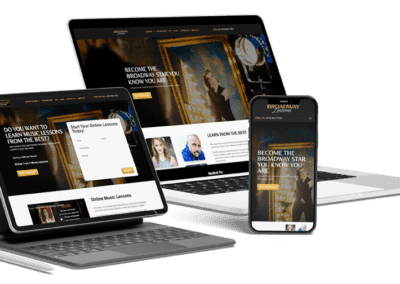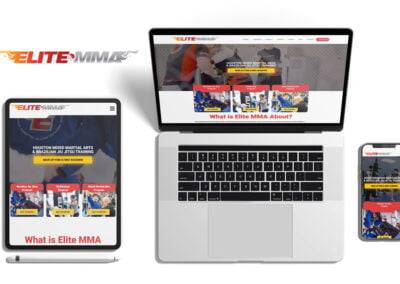
Essential Considerations for a Successful Website Redesign
Businesses invest in website redesign for various reasons, including increasing conversion rates to generate more leads and sales, leveraging new technologies like mobile-friendly design, improving the overall appearance and user experience of the site, and gaining better control over website management and updates. These are just a few reasons why one might consider redesigning their website.
Website redesign is often associated with graphic design, giving an older website a fresh look to attract attention from visitors and customers. It may also involve adding more content to provide readily available information to existing and potential customers. However, this approach can sometimes result in complex and confusing websites for visitors.
Many websites fail to capture visitor information or contribute effectively to qualifying potential customers and supporting the pre-sales process. Therefore, redesigning websites becomes necessary as the internet evolves, with increasing bandwidth, emerging technologies, and changing user expectations. What was once considered a luxury has now become a necessity.
Less sophisticated websites tend to age quickly compared to interactive ones, especially as internet users expect more from websites. Google favors mobile-friendly websites, making it the perfect time to create a website that meets these requirements. Here are some considerations during the redesign process to ensure your site is error-free before launch.
Preserve Your Website Assets:
A solid website redesign strategy starts with preserving your website assets. When embarking on a redesign project, it’s crucial to identify what is currently working for you and ensure that these valuable assets are not lost in the process.
Begin by examining your highest entry and conversion pages. These pages are the gateway for attracting visitors and converting them into customers. Take note of their structure, content, and design elements that contribute to their success. By preserving the essence of these pages, you can maintain their effectiveness in generating leads and driving conversions.
Additionally, pay close attention to your Google rankings and keywords. Conduct a thorough analysis of your current search engine optimization (SEO) efforts to identify the keywords that are driving organic traffic to your site. Keep track of your rankings for these keywords and ensure that the redesigned website retains the necessary elements to maintain or improve these rankings. It’s important to avoid sudden drops in organic visibility during the transition.
Furthermore, consider the inbound links pointing to your site. Backlinks from reputable and relevant sources are valuable for your website’s authority and search engine ranking. When redesigning your website, ensure that these links are properly redirected or maintained to preserve the SEO value they provide. Broken or lost links can have a negative impact on your organic traffic and overall online presence.
By being aware of and preserving these crucial website assets, you can avoid eliminating valuable components that contribute to your lead generation and customer acquisition efforts. A thoughtful approach to website redesign will help you retain the elements that have proven successful while incorporating necessary improvements for a more effective online presence.
Design for Your Users:
 When it comes to website success and achieving your goals, designing with your target users in mind is paramount. To create a website that truly resonates with your audience, it’s essential to understand their expectations, behaviors, and the questions they seek answers to.
When it comes to website success and achieving your goals, designing with your target users in mind is paramount. To create a website that truly resonates with your audience, it’s essential to understand their expectations, behaviors, and the questions they seek answers to.
Simplicity is key in web design. Users appreciate clean and intuitive interfaces that allow them to navigate effortlessly. Stick to current design trends that users are familiar with, such as placing the logo on the left side of the header and providing straightforward navigation menus. These familiar design patterns ensure that users can quickly find what they’re looking for and feel comfortable exploring your website.
Additionally, consider the overall aesthetic of your website. Your design should align with your industry and reflect your brand’s personality. It’s important to strike a balance between creativity and conventionality. While you want your website to stand out, deviating too far from user expectations can harm the user experience. Google research has shown that users tend to prefer websites that are simple, familiar, and easy to navigate.
To better understand your users’ needs, conduct user research and gather insights about their preferences and pain points. This can be done through surveys, interviews, and usability testing. By gaining a deep understanding of your users, you can tailor your design to meet their expectations and provide them with a seamless browsing experience.
Remember, your website is a tool for your users to achieve their goals, whether it’s finding information, making a purchase, or engaging with your content. By designing with their needs in mind, you increase the chances of capturing their attention, keeping them engaged, and ultimately driving the desired actions.

Keep Your Text Consistent:
Consistency in your website’s text and content is essential for maintaining a professional and cohesive brand image. When undergoing a website redesign, it’s crucial to establish clear guidelines for your content editors to follow. Here are some tips to ensure text consistency throughout your redesigned website:
- Establish Style and Brand Guidelines: Create a comprehensive style guide that outlines the preferred writing style, tone, and voice for your brand. This guide should cover aspects such as grammar rules, punctuation, capitalization, and formatting conventions. By providing your content editors with these guidelines, you ensure that all text on your website adheres to a consistent and unified style, enhancing readability and brand coherence.
- Standardize Company and Brand Names: Consistency in how your company and brand names are presented is essential. Define the preferred variations and ensure that your content editors strictly adhere to them. This includes ensuring consistent capitalization, spacing, and punctuation of the company or brand name. By standardizing these elements, you present a unified brand identity and avoid confusion among your audience.
- Update Department Names and Employee Titles: If your organization has undergone reshuffling or rebranding, take advantage of the website redesign process to ensure that new department names and employee titles are consistently used across all content. This includes updating the names and titles within the website’s copy, headers, and any relevant documentation. Consistency in how you refer to different departments and roles within your organization helps establish clarity and professionalism.
- Utilize Content Management Systems: Implementing a content management system (CMS) can streamline the content creation and editing process. CMS platforms often include features like templates, content reuse, and centralized control, enabling you to maintain consistency across your website. With a CMS, you can create predefined content modules, standardized templates, and reusable components that ensure consistent formatting, layout, and messaging throughout your site.
- Conduct Quality Assurance and Proofreading: Before launching the redesigned website, invest time in conducting thorough quality assurance and proofreading processes. Assign a team or individual responsible for reviewing all the content on the site to ensure consistency, accuracy, and adherence to the established guidelines. Look for any inconsistencies in terms of spelling, grammar, formatting, and brand representation. By catching and correcting these issues before going live, you present a polished and professional website to your audience.
By implementing these measures to keep your text consistent, you maintain a strong brand identity and deliver a cohesive user experience. Consistency in writing style, brand and company names, department names, and employee titles helps build trust, credibility, and recognition among your audience. It also reflects a commitment to quality and attention to detail, enhancing the overall effectiveness of your website and its content.
Optimize Your Website:

In today’s digital landscape, optimizing the technical aspects of your website is crucial, regardless of whether your primary goal is to achieve high search engine rankings. By paying attention to technical optimization, you can enhance the overall performance, user experience, and visibility of your website. Here are some key areas to focus on during the website redesign process:
- Implement Permanent Redirects (301 Redirects): If you have renamed or moved any URLs on your website, it’s important to implement permanent redirects (301 redirects) from the old URLs to the new ones. This ensures that any existing links or bookmarks pointing to the old URLs will be redirected to the appropriate pages on your redesigned website. By using 301 redirects, you not only avoid broken links but also preserve the SEO value associated with the old URLs, such as inbound links and search engine rankings.
- Update Meta Data: As part of the website redesign process, review and update the meta data for each page. Meta data includes the title tag, meta description, and other relevant meta tags. Ensure that these elements accurately reflect the content of each page and incorporate relevant keywords. Optimized meta data helps search engines understand the context and relevance of your web pages, improving your chances of ranking higher in search engine results and attracting organic traffic.
- Optimize Website Images: Images play a significant role in website aesthetics and user engagement. However, large image file sizes can slow down page load times, negatively impacting the user experience. To optimize your website, compress and resize images without compromising their quality. This reduces the file size and improves page loading speed. Additionally, make use of descriptive alt tags for images to provide alternative text that can be read by search engines, helping with accessibility and potential keyword optimization.
- Mobile-Friendly Design: With the increasing use of smartphones and tablets, it is essential to ensure that your website is mobile-friendly. Responsive design, which automatically adjusts the layout and content to fit different screen sizes, is a recommended approach. A mobile-friendly website provides a seamless browsing experience, improves user engagement, and contributes to higher search engine rankings. Additionally, search engines like Google prioritize mobile-friendly websites in their mobile search results, making it even more important to optimize for mobile devices.
- Monitor Website Performance: After the website redesign, regularly monitor your website’s performance using tools like Google Analytics or other website analytics platforms. Keep an eye on key metrics such as page load times, bounce rates, and user engagement. Analyzing these metrics can help you identify any performance issues and take corrective measures to optimize your website further.
By focusing on these technical optimization aspects during your website redesign, you can improve the overall functionality, user experience, and search engine visibility of your website. Optimized websites not only attract more organic traffic but also provide a seamless and satisfying experience for your visitors, increasing the chances of conversions, engagement, and overall success.
Test for Usability:
Usability testing is a crucial step in the website redesign process as it ensures that your website is user-friendly, functional, and accessible to your target audience. By conducting thorough usability tests, you can identify and address any issues or obstacles that may hinder users’ ability to navigate and interact with your website effectively. Here are some key aspects to consider when conducting usability tests for your redesigned website:
- Navigation and Site Structure: Test the navigation menus and site structure to ensure that users can easily find the information they need. Check if the menu labels are clear and intuitive, and if the overall site architecture allows for logical and effortless navigation. Observe how users interact with your website’s menus, links, and search functionality to identify any areas of confusion or frustration.
- Content Readability and Clarity: Evaluate the readability and clarity of your website’s content. Check if the font sizes, colors, and styles are easy to read, especially on different devices and screen sizes. Ensure that the content is well-organized with appropriate headings, subheadings, and paragraphs. Test the legibility of your text under different lighting conditions and assess if the contrast between the text and background is sufficient for easy comprehension.
- Browser and Device Compatibility: Test your redesigned website across different web browsers (such as Chrome, Firefox, Safari, and Edge) to ensure consistent performance and display. Check if all website features, including multimedia elements, function correctly and are displayed properly on various browsers and their different versions. Additionally, test your website on different devices, such as desktops, laptops, tablets, and smartphones, to ensure it is responsive and optimized for a seamless user experience.
- Page Loading Speed: Assess the loading speed of your web pages to determine if they meet user expectations. Slow-loading pages can lead to frustration and abandonment. Test your website’s performance using tools like Google PageSpeed Insights or GTmetrix to identify areas for improvement. Optimize images, minimize server requests, and implement caching techniques to enhance page loading speed.
- Link Functionality and Accessibility: Ensure that all internal and external links on your website are working correctly. Test the functionality of links to external sources, such as social media profiles, downloadable files, or partner websites. Additionally, verify that the links within your website are properly formatted, descriptive, and accessible to screen readers or assistive technologies for users with disabilities.
- User Feedback and Observation: Gather feedback from representative users through surveys, interviews, or user testing sessions. Observe how users interact with your redesigned website and note any issues, confusion, or areas of improvement they encounter. Pay attention to their feedback on the overall user experience, ease of use, and any specific pain points they may encounter.
By conducting thorough usability tests, you can identify and address any usability issues before launching your redesigned website. Usability testing helps ensure that your website provides a seamless and user-friendly experience, regardless of the user’s device, browser, or level of familiarity with technology. By prioritizing usability, you enhance user satisfaction, engagement, and ultimately, the success of your website.

Why Hire an Award-Winning Agency like EWR Digital for Your Website Redesign?
Why Hire an Award-Winning Agency like EWR Digital for Your Website Redesign?
When it comes to redesigning your website, partnering with an award-winning agency like EWR Digital can be a game-changer. Here’s why you should consider hiring us for your website redesign:
- Expertise and Experience: As an award-winning agency, EWR Digital has a proven track record of delivering exceptional website redesigns for a diverse range of clients. Our team consists of highly skilled professionals who specialize in web design, development, and digital marketing. With years of experience in the industry, we understand the nuances of effective website design and can tailor solutions to meet your specific goals and requirements.
- Cutting-Edge Design: Our agency stays up-to-date with the latest design trends, technologies, and user experience (UX) best practices. We combine creativity with strategic thinking to create visually stunning websites that not only captivate your audience but also provide seamless navigation and intuitive user interfaces. Our focus is on designing websites that not only look great but also deliver an exceptional user experience, ultimately driving conversions and achieving your business objectives.
- Customized Solutions: At EWR Digital, we believe in the power of customization. We take the time to understand your brand, target audience, and unique business goals. Our team works closely with you to develop a comprehensive website redesign strategy that aligns with your vision and objectives. We strive to create a website that not only represents your brand accurately but also resonates with your target audience, effectively conveying your message and value proposition.
- Strategic Approach: Our website redesign process is guided by a strategic approach. We conduct thorough research and analysis to identify your target audience, competitors, and market trends. This data-driven approach allows us to make informed decisions throughout the redesign process, ensuring that every element of your website is purposeful and aligned with your business objectives. We focus on creating a website that not only looks visually appealing but also drives traffic, engages users, and generates measurable results.
- Integrated Digital Marketing: A website redesign is not just about aesthetics; it’s about maximizing your online presence and achieving your digital marketing goals. At EWR Digital, we offer integrated digital marketing services that complement your website redesign. From search engine optimization (SEO) to content marketing and social media strategies, we ensure that your website is optimized for visibility, engagement, and conversion. Our goal is to create a cohesive digital ecosystem that strengthens your online presence and delivers a higher return on investment (ROI).
- Industry Recognition: Being an award-winning agency speaks volumes about our expertise, creativity, and dedication to delivering exceptional results. Our accolades demonstrate our ability to exceed client expectations, provide innovative solutions, and create impactful websites. By choosing EWR Digital, you are partnering with a recognized agency that has been acknowledged for its excellence in the industry.
In conclusion, hiring an award-winning agency like EWR Digital for your website redesign can provide you with the expertise, creativity, and strategic thinking needed to create a visually stunning, user-friendly, and high-performing website. With our experience, customized solutions, and integrated digital marketing services, we can help you achieve your business goals, enhance your online presence, and stand out from the competition.




